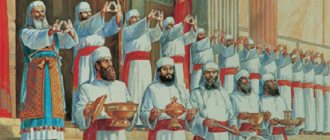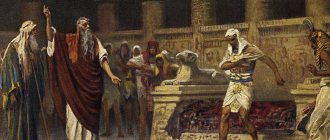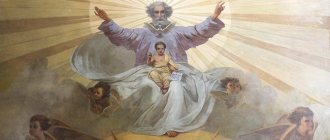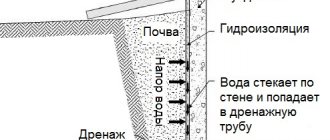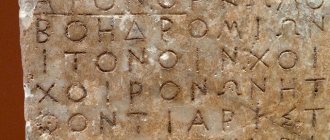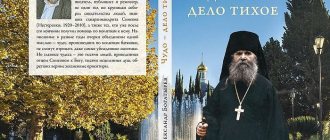The barren fig tree is a phraseological unit
Before the revolution in Russia, it was considered good form to know the text of the Holy Scriptures. Cultured, educated people studied the Old and New Testaments. So they knew what they said.
However, many of them were not considered religious and even opposed religion.
N. Bogdanov-Belsky. Sunday reading at a rural school. 1895. Russian Museum. Representatives of the intelligentsia are present in the picture
It was from among the intelligentsia that biblical phraseological units began to penetrate the people. These are stable expressions that have a pronounced emotional and evaluative character. They have a figurative meaning and allow you to make speech vivid and figurative.
Biblical phraseological units form biblical phraseology, that is, a set of expressions going back to the Bible. Biblical phraseological units usually come from the books of the Old and New Testaments.
Biblical phraseological units come from the books of the Old and New Testaments.
The expression “barren fig tree” also belongs to biblical phraseological units. It comes from a New Testament parable. Its content is as follows: one day Jesus was walking along the road and saw a fig tree. He approached her and did not see a single fruit on her. Then Christ said:
“Let there be no fruit from you henceforth forever.”
(Matt. 21.19)
After the Savior’s words, the tree withered.
Biblical phraseology is a stable expression that has an emotional connotation and symbolic meaning.
Naturally, the parable is symbolic and has a figurative meaning, so this biblical text does not need to be understood literally. As for deciphering the expression “barren fig tree,” the meaning of the phraseological unit is twofold.
So, in the first case, a childless woman is called by this name. In the second, a similar characteristic is given to someone who engages in fruitless activities.
Fig tree is a fig or fig tree.
The fig tree goes by several names. So it is also called figs and figs. In addition, there is also the name “wine berry”.
From a botanical point of view, it is a subtropical deciduous plant. Its Latin name is Ficus carica. This is a tree from the Ficus genus, the Mulberry family.
The homeland of figs is the mountainous regions of Caria. In ancient times, one of the provinces in Asia Minor had this name. It is grown as a valuable fruit plant, because one produces fruits called wine berries.
The distribution area of the fig tree is wide. For example, it is widespread in Central Asia, the Mediterranean, and the Iranian Plateau.
A fig tree is a fig or fig tree. It is often mentioned in the Bible, for example, the only tree mentioned as growing in the Garden of Eden
It is believed that figs are the most ancient cultivated plant. It was originally grown in Arabia. Later it was borrowed by the Egyptians, Syrians, and Phoenicians. They also knew the fig tree in the territory of Ancient Judea.
The leaves of the fig tree are large and have three, five or seven lobes. They are hard and tough. The juicy, sweet pear-shaped fruits are eaten. They are covered with thin skin with small hairs.
The color of fig fruits varies from yellow to black-blue. The most common fruits are yellow-green. In addition, figs are used in medicine as a medicine, for example, to treat bronchial asthma.
The biblical fig tree refers to the syquimore
It should be noted that the biblical fig tree is an ordinary fig tree, to which everyone is accustomed. The fig tree in the Holy Scriptures refers to the syquimore. Syquimora or “wild fig tree,” like the common fig tree, belongs to the genus Ficus of the Mulberry family.
Syquimore is the biblical fig tree. Biologically speaking, it is a wild variant of the fig. The main difference from a cultivated fig tree is that it harvests once a year.
It is an evergreen tree that grows in African savannas and forests. Its trunk is straight, has a height of 30 - 40 meters, and in Palestine up to 20.
In cold winters, the plant may shed its leaves. Branches with milky juice. The leaves are large, 18 - 20 centimeters long, oval in shape.
Sykmore in Palestine grows up to 20 meters in height.
Syquimore fruits are edible, but they are smaller than the fruits of real figs. The inhabitants of Judea often ate them, as the prophet Amos collected them (Mam. 7:14). Moreover, the main value of the biblical fig tree lies in its wood, not its fruits.
The fact is that the plant has a fast-growing straight trunk. It is suitable for any construction work.
The syquimore differs from the ordinary fig tree in that it is an evergreen tall tree with a slender trunk. The fig tree is a short tree with a thick trunk. The fig tree produces two types of fruit: juicy and dry, while the syquimore produces one.
The fig tree grows in the cool subtropics, while the syquimore grows in Africa, in warmer areas.
Nowadays, the biblical fig tree grows wild. Scientists claim that it was originally brought here by man as a valuable economic tree species. The Bible says that King Solomon began growing syquimore in Judea and Palestine (1 Kings 10:27, 2 Chronicles 1:15).
The fact is that he did not want to buy construction wood from other nations and decided to plant syquimore groves on the territory of his own country.
In addition, such groves, planted in territories disputed with neighboring tribes, symbolized the dominance of King Solomon over them.
King Solomon in old age. Engraving by Gustave Doré. King Solomon decided to plant syquimore groves in Israel in order to provide it with timber
In the Synodal translation, the syquimore is sometimes called a fig tree. This is important for understanding the meaning of the parable of the barren fig tree. Most likely, Jesus cursed an ordinary fig tree that sheds its leaves.
The wild version of this plant never sheds its leaves. Moreover, according to Coptic legend, the holy family took refuge under a syquimore tree during his flight to Egypt.
Thus, Jesus must have known its distinctive features and been able to distinguish it from the domestic fig tree, the fruits of which are much tastier and juicier.
Moral aspect
Our God (Christ) is patient. And he waits for His word to enter our hearts, sprout and bear fruit in due time. He not only wants to see us in eternity, He wants us to grow in the knowledge of the truths of God and bear fruit abundantly. What fruits can we bear today: stop deceiving, stop being angry and hating; be vulnerable to criticism; try to get along with your spouse, with a colleague at work; visit parents, maybe one of the sick or infirm; fulfill promises. Share the burden of labor with someone. Maybe take part in some charity event. And this is not difficult, it is much more difficult to forgive grievances, debts, betrayal, technical, medical and legal errors - these are, perhaps, the rarest fruits.
But God is looking for them too. It is difficult to comment on such mistakes, but I have living evidence from one of my friends, a patient with a severe form of cerebral palsy, who received his illness in the first hours of his life due to the careless actions of staff. But this man did not become embittered. I have never seen so many friends involved in communication with a patient who is deprived of the ability to move independently. He even managed to visit different places in our country. God gave him joy and peace. Such fruits ripen where there is incredible vitality, love of life, a calm positive outlook on any events; where the realization comes that God has forgiven us the insults of others, and our debts to others (remember Our Father: and forgive us our sins, for we also forgive every debtor), and our betrayal, and our professional and everyday mistakes, because which others suffered.
The Bible repeatedly talks about the fig tree
The Bible often mentions the fig tree. This tree is the only one mentioned among the many trees that grew in the Garden of Eden (Gen. 3:7).
That is why Adam and Eve made clothes for themselves from the leaves of a fig tree or a fig tree after they ate the forbidden fruit from the Tree of the Knowledge of Good and Evil.
Titian - Adam and Eve Titian. 1488 - 89 years. Adam and Eve, having tasted the forbidden fruit and recognized their nakedness, covered their nature with the leaves of the fig tree.
In addition, the Holy Scriptures also say that there were always many fig trees growing in Palestine (Deut. 8:8). Among the Jews, this tree, which has a wide crown and produces sweet, tasty fruits, has always been considered a symbol of peace and prosperity.
Figs began to ripen on the feast of Pentecost. From this day the annual cycle began, during which the fig-fig bears fruit.
In total, the tree produced three harvests. Early figs were especially prized (Isa. 28:4; Jer. 24:2; Nahum. 3:12). The failure of the fig harvest was considered a great disaster.
Fruits of the fig tree or fig. They began to ripen with the feast of Pentecost. First, fruits appeared on the tree, and then leaves
On this tree, fruits appear first and then only leaves grow. The appearance of leaves means the onset of summer. Naturally, a tree with leaves but no fruit is worthy of condemnation.
The appearance of leaves on a fig tree indicates the coming of summer.
All this information is necessary in order to correctly understand the act of Christ. Without them, it is impossible to understand the meaning of the parable and understand why Jesus cursed the fig tree.
The significance of this act of the Savior is so great that it is mentioned not only in the Gospel of Matthew 21.19, but also three more times: (Matthew 21.20, Mark 11:20, 11:21).
Who will stand up for a doomed man?
As a rule, in parables where the characters include a king, or a lord, or a master, he symbolizes God. This parable is no exception. However, in addition to the owner, there is another person in the parable - the vinedresser, who intercedes for the fig tree and promises to work so that it finally begins to bear fruit. Who is this intercessor?
The Old Testament is replete with examples of people interceding with God on behalf of people, asking God to show patience with them. Abraham interceded for the inhabitants of Sodom, asking: Will You really destroy the righteous with the wicked?.. It cannot be that You would do such a thing... it cannot be from You! Will the judge of all the earth act unjustly? And then he asks whether God will destroy Sodom if at least fifty, forty-five, forty, thirty, twenty or ten righteous people remain in the city (Gen. 18:22-33). The dialogue resembles a bargaining: Abraham gradually reduces the number of righteous people, and God in response promises not to destroy the city even for the sake of ten righteous people.
The understanding of Divine justice presented here is different from that which follows from the teaching of Jesus in the Gospel of Luke. Abraham assumes that sudden death is a punishment for sin and that the righteous must be saved from it. Jesus says the opposite: the victims of persecution or accident were no more sinful than those who survived. Divine justice acts differently than it appears to people. God leaves alive not only the righteous, but also sinners to give them the opportunity to repent and change their lives (just as He leaves the tares to grow along with the wheat until harvest time).
Another example of intercession with God for the people was Moses. While he was at Sinai, the people made a golden calf and began to worship it. God said to Moses about this: I see this people, and behold, they are a stiff-necked people; Therefore leave Me, that My wrath may burn against them, and I may destroy them, and make of you a great nation. But Moses began to contradict God, reminding Him of the promises He gave to Abraham, Isaac and Jacob. And God abolished the evil which He had said He would bring upon His people (Exodus 32:1–14). Moses himself carried out justice, as he understood it, and about three thousand people died by the sword of the sons of Levi (Exodus 32:25-28). After that, he returned to God and said: This people have committed a great sin... forgive them their sin, and if not, then blot me out of Your book, in which You wrote. This time God remained implacable: I will blot out the one who sinned against Me from My book. And he smote the people because of the calf he had made (Exodus 32:31–35).
The images of the Old Testament righteous who interceded for the people serve as prototypes of that intercessor with the Father, Jesus Christ, the righteous One, who is the propitiation for our sins, and not only for ours, but also for the sins of the whole world (1 John 2:1-2). He, who abides forever, also has an imperishable priesthood, and therefore can always save those who come to God through Him, being always alive to intercede for them (Heb. 7:24-25). Like Moses, who asked to be blotted out of the book of life, Jesus sacrificed His life for the people: He died, but also rose again: He is also at the right hand of God, and He makes intercession for us (Rom. 8:34).
It was in this vein that the ancient interpreters understood the parable. According to Isidore Pelusiot, the owner of the vineyard is God, the vinedresser is the Son of God, and the fig tree is the people of Israel or all humanity. The law and the prophets failed to correct the people and make them bear fruit. The Son of God, through His teaching and His sufferings, must lead them to repentance. If this does not happen, in eternal life they will be cut off from part of the righteous (Isidore Pelusiot. Letters 1, 312 (PG 78, 364). Russian translation: p. 181).
In the light of the New Testament concept of Jesus Christ as an intercessor before God not only for the chosen people, but also for the whole world, one should understand the words of the vinedresser addressed to the owner. Even if the patience of God the Father is exhausted, the Son of God is ready to act as a mediator between Him and sinful people. This brings a complete revolution to the concept of divine justice. From now on, even a barren fig tree has an intercessor in the person of a good winegrower, who is ready to dig up and fertilize it, “if it bears fruit.”
Jesus cursed the fig tree because it did not feed Him
Jesus was in Bethany before entering Jerusalem. From here He went to the holy city to preach there in the Temple. Jerusalem lies three kilometers from Bethany.
Curse of the fig tree. Book miniature from the Arabic Gospel of the 17th century. Jesus cursed the barren fig tree because it did not feed him. This is an explanation of the action of Christ in the flesh
In Bethany, Christ and his disciples stayed in the house of Martha. It was Tuesday. It is quite possible that Jesus’ disciples had breakfast at Martha’s house, and the Savior himself used this time for prayer. Later on the journey He became hungry and wanted to eat something.
Passing by an area called Bethphage, which translated means “house of figs,” Christ saw a fig tree standing near the road. Green leaves grew on it.
Jesus went to her in order to satisfy her hunger with fruits. He couldn't see them under the thick canopy and was very disappointed when he couldn't find them.
Seeing that there is no fruit on the tree, Christ curses it, saying:
“From now on, let no one eat fruit from you forever!”
(Mark 11:14)
Despite the fact that the Savior’s disciples walked at a distance from Him, they heard this phrase. The Apostle Mark was even surprised and asked why the Teacher was looking for fruit on the fig tree, although he knew that at this time of year it was not yet laying ripe fruits.
TV channel Spas. Conversations with the priest. Great Tuesday. Broadcast from April 26, 2021 In the second minute, the author talks about the events of Tuesday of Holy Week and who gave Jesus power over the forces of nature.
This is a human explanation for what Jesus did. At the same time, it is necessary to know that in the time of Christ all learned conversations were conducted in an allegorical sense.
In addition, a teacher or religious figure could, through his actions, which also had symbolic meaning, indicate a particular event or concept.
Therefore, the act of Christ, who cursed the barren fig tree, has a symbolic meaning.
Empty
- Seal
The entire Holy Week, starting with Palm Sunday itself, is closely tied to the Gospel narrative. It seems to trace the last days of the Savior’s earthly life. That is why every day of this week the Gospel is read twice: at Matins and at Vespers, in contrast to the rest of the time of Lent, when we could hear the Gospel words only on Saturdays and Sundays.
At Matins on Holy Monday the story of the barren fig tree is read. This story is told by two Evangelists, Matthew and Mark. Let's look at both texts.
St. Evangelist Matthew describes the episode with the fig tree briefly, emphasizing the idea that he considered the main one, namely: if you have faith and do not doubt, then nature will obey the command of Christ’s disciples. Here is how the Evangelist Matthew wrote:
“In the morning, returning to the city, [Christ] became hungry; and seeing a fig tree along the road, he approached it and, finding nothing on it except some leaves, said to it: Let there be no fruit from you henceforth forever. And the fig tree immediately withered. Seeing this, the disciples were surprised and said: How did the fig tree immediately wither? Jesus answered and said to them, “Truly I say to you, if you have faith and do not doubt, you will not only do what was done to the fig tree, but even if you say to this mountain, “Be taken up and thrown into the sea,” it will happen. and whatever you ask in prayer with faith, you will receive” (Matthew 21: 18-22).
The Gospel of Mark gives this episode in more detail:
“The next day, when they came out of Bethany, He became hungry; and seeing from afar a fig tree covered with leaves, he went to see if he could find anything on it; but when he came to her, he found nothing but leaves, for it was not yet time to gather figs. And Jesus said to her: From now on let no one eat fruit from you forever! And His disciples heard it” (Mark 11: 12-14).
And then the evangelist describes the events in Jerusalem (Mark 11: 15-19) and then returns again to the story of the fig tree:
“In the morning, as we passed by, we saw that the fig tree had dried up to the roots. And, remembering, Peter said to Him: Rabbi! Look, the fig tree that You cursed has dried up. Jesus, answering, says to them: have faith in God, for truly I say to you, if anyone says to this mountain, “Be taken up and thrown into the sea,” and does not doubt in his heart, but believes that what he says will happen, it will be done for him no matter what. will say. Therefore I tell you: whatever you ask in prayer, believe that you receive it, and it will be done for you. And when you stand in prayer, forgive if you have anything against anyone, so that your Heavenly Father may forgive you your sins. If you do not forgive, then your Heavenly Father will not forgive you your sins” (Mark 11: 20-26).
St. Evangelist Mark mentions one important detail: it was not the time for picking figs! What is the tree’s “fault”? And what moved the Lord when He uttered the words of curse: anger, reckless whim, a manifestation of the weakness of human nature, ignorance of the laws of nature? Or does everything that happened have a deeper meaning?
Let us note first of all that the miracle with the fig tree was performed by the One who had previously said through the prophet about Himself: “I am the one who withers up the green tree and makes the dry tree sprout (Ezek. 17:24)”, the One who created heaven and earth, every being and tree , and the entire universe.
Everything that happened on the approaches to Jerusalem has the deepest symbolic meaning and is described in symbolic language. The fig tree is a symbol that was very often used in the Holy Scriptures, not only of the New Testament, but also of the Old Testament. The Savior Himself repeatedly resorted to it during His preaching. In order to correctly understand the miracle of the fig tree, it is necessary to keep in mind and understand all other parallel passages in which the fig tree is mentioned in a symbolic and literal sense.
To begin with, let us recall an event that took place a year before the time we are describing. St. tells about him. Evangelist Luke.
6. And he spoke this parable: A man had a fig tree planted in his vineyard, and he came looking for fruit on it, and found none; 7. And he said to the Husbandman: Behold, I have come for the third year looking for fruit on this fig tree, and have not found it; cut it down: why does it occupy the land? 8. But He answered Him: Master! leave it this year too, until I dig it up and cover it with manure, 9. lest it bear fruit; if not, then next [year] you will cut it down. (Luke 13:6-9)
Someone is the Master of the garden, God, who comes to seek the fruits of virtue in His vineyard. The vinedresser is the Son of God Himself, Christ, who appeared in the flesh in order to take care of and cleanse the vineyard. The vineyard is the house of Israel, as it is called by the prophet Isaiah. Fig tree - Jewish host.
Using this fig tree as an example, we understand that a tree must bear fruit. A good tree means good fruit. A tree that is barren and does not bear good fruit is cut down and thrown into the fire. 3 years is the time of the ministry of Jesus Christ. During these 3 years, He called Israel to repentance, performed miracles, preached, showing that He was the long-awaited Messiah. However, all these 3 years, Israel, like the fig tree, did not bear any fruit of repentance, rejecting Jesus. In the parable, the husbandman begs his master (a reference to Christ) to wait another year. He promises to “dig it up and cover it with manure to see if it bears fruit.” If after a year everything remains the same, the fig tree will definitely be cut down.
It cannot be ruled out that in the parable told a year ago, the Lord meant the same tree, having long ago noticed its barrenness, which he made a symbol of the barrenness of the Jewish host. The Lord gave him 3 years - the time of His preaching, warning that the ax was already lying at the root of the fig tree. The curse of this tree at the end of His ministry symbolized the end of this period and the curse of the host itself.
It is interesting that by pronouncing this parable with a warning, Christ was actually repeating the symbolic parable of the prophet Isaiah, bringing it to its logical conclusion.
Is. : 7. The vineyard of the Lord of hosts is the house of Israel, and the men of Judah are his favorite planting. And He waited for justice, but behold - bloodshed; I was waiting for the truth, and then - a cry. … 25. Therefore the wrath of the Lord will be kindled against His people, and He will stretch out His hand against them and smite them, so that the mountains will tremble, and their corpses will be like dung in the streets. And despite all this, His anger will not be turned away, and His hand will still be stretched out.
It will not be superfluous to familiarize yourself with the full text of the prophet Isaiah about the beloved vineyard. For those interested, here is the text:
Isa.: 5, 1 – 13. I will sing to my Beloved the song of my Beloved about His vineyard. My Beloved had a vineyard on the top of a fattened mountain, and He surrounded it with a fence, and cleared it of stones, and planted choice vines in it, and built a tower in the midst of it, and dug a winepress in it, and expected it to bear good grapes. , and he brought wild berries. And now, inhabitants of Jerusalem and men of Judah, judge between Me and My vineyard. What more should I have done for My vineyard that I have not done for it? Why, when I expected him to bring good grapes, did he bring wild berries? Therefore I will tell you what I will do to my vineyard: I will take away its hedge, and it will be desolate; I will destroy its walls, and it will be trampled down, and I will leave it desolate: they will neither prune it nor dig it, but it will be overgrown with thorns and thistles, and I will command the clouds not to rain rain on it. The vineyard of the Lord of hosts is the house of Israel, and the men of Judah are His beloved planting. And He waited for justice, but behold - bloodshed; I was waiting for the truth, and then - a cry. Woe to you who add house to house, adding field to field, so that there is no room left for others, as if you alone were settled on the earth. The Lord of hosts said in my ears: these many houses will be empty, large and beautiful - without inhabitants; ten plots of vineyard will yield one bath, and a homer of grain sown will barely yield an ephah. Woe to those who look for strong drink from early morning and warm themselves with wine until late in the evening; and the harp and harp, the tambourine and the flute, and the wine at their feasts; but they do not look at the works of the Lord and do not think about the work of His hands. For this reason, my people will go into captivity unexpectedly, and their nobles will starve, and their rich people will languish with thirst. Therefore, the underworld expanded and opened its mouth without measure: and their glory and their wealth, and their noise and everything that makes them happy, will descend there. And man will bow, and man will humble himself, and the eyes of the proud will droop; and the Lord of hosts will be exalted in judgment, and the Holy God will reveal His holiness in righteousness. And the sheep will graze of their own accord, and strangers will eat the rich pastures left behind by the rich. Woe to those who drag iniquity upon themselves with ropes of vanity, and sin as with the straps of a chariot; who say: “Let Him make haste and hasten His work, so that we may see, and let the counsel of the Holy One of Israel draw near and come to fruition, so that we may know!” Woe to those who call evil good and good evil, who consider darkness to be light and light to be darkness, who consider bitter to be sweet and sweet to be bitter! Woe to those who are wise in their own eyes and understanding in themselves! Woe to those who are brave to drink wine and strong to prepare strong drink, who justify the guilty for gifts and deprive the just of the lawful! For as fire eats up the stubble, and the flame consumes the hay, so their root will rot, and their flower will be scattered like dust; because they rejected the law of the Lord of hosts and despised the word of the Holy One of Israel. Therefore the wrath of the Lord will be kindled against His people, and He will stretch out His hand against them and smite them, so that the mountains will tremble, and their corpses will be like dung in the streets. And despite all this, His anger will not be turned away, and His hand will still be stretched out. And he will raise a banner to the distant nations, and give a sign to those who live on the ends of the earth, and behold, he will come easily and quickly; He will not have anyone who is tired or weary; no one will slumber or fall asleep, and the belt of his waist will not be taken off, and the thong of his shoes will not be torn; his arrows are sharpened, and all his bows are drawn; The hoofs of his horses are like flint, and his wheels are like a whirlwind; his roar is like the roar of a lioness; he roars like the skimn, and roars, and seizes the prey and carries it away, and no one will take it away. And on that day it will roar against him like the roar of an angry sea; and he will look at the earth, and behold - darkness, grief, and the light has faded in the clouds.
It is not difficult to notice that the words of the prophet Isaiah surprisingly resonate with another parable of the Savior about the evil winegrowers, that is, the servants of the Jewish community, which was read on the same day in the evening.
Holy Gospel of Matthew 21:33-46
33. Listen to another parable: there was a certain owner of a house who planted a vineyard, surrounded it with a fence, dug a winepress in it, built a tower and, having given it to winegrowers, went away. 34 When the time for fruit approached, he sent his servants to the vinedressers to take their fruit; 35. The winegrowers seized his servants, beat some, killed others, and stoned others. 36. Again he sent other servants, more than the first; and they did the same to them. 37. Finally, he sent his son to them, saying: They will be ashamed of my son.
38. But the husbandmen, when they saw the son, said to one another, “This is the heir; Let's go, kill him and take possession of his inheritance. 39. And they seized him, took him out of the vineyard and killed him. 40. So, when the owner of the vineyard comes, what will he do with these vinedressers? 41. They say to Him: These evildoers will be put to an evil death, and the vineyard will be given to other vinedressers, who will give him the fruit in their own time.
42. Jesus said to them: Have you never read in the Scripture: the stone which the builders rejected has become the head of the corner? Is this from the Lord, and is it marvelous in our eyes?
43. Therefore I tell you that the kingdom of God will be taken away from you and given to a people bearing the fruits thereof; 44. And whoever falls on this stone will be broken, and whoever it falls on will be crushed.
45. And hearing His parables, the high priests and Pharisees understood that He was speaking about them, 46. and tried to seize Him, but they were afraid of the people, because they considered Him to be a Prophet.
Thus, with the parable of the evil winegrowers and the miracle of the fig tree, the Lord wanted to show that the time had come for the fulfillment of the terrible prophecies of St. the prophet Isaiah and the “vineyard of the Lord of hosts.”
What fruits did the Lord seek from the fig tree - the Jewish host? Repentance. Repentance would change condemnation to mercy. Just as the congregation, that is, the Jewish Church, did not bring repentance, so the fig tree in Jerusalem did not bear fruit. And how can we not recall another text related to the fig tree.
“Jesus entered Jericho and passed through it. And so, someone named Zacchaeus, the chief of publicans and a rich man, sought to see Jesus who He was, but he could not follow the people, because he was small in stature, and, running ahead, he climbed up a fig tree to see Him, because He had to pass by her. When Jesus came to this place, he looked, saw him and said to him: Zacchaeus! come down quickly, for today I need to be in your house. And he hastened down and received Him with joy.
And everyone, seeing this, began to murmur and said that He had come to a sinful man; Zacchaeus stood up and said to the Lord: Lord! I will give half of my property to the poor, and if I have offended anyone, I will repay him fourfold. Jesus said to him, “Now salvation has come to this house, because he also is a son of Abraham, for the Son of Man came to seek and to save that which was lost” (Luke 19:1-10).
The Jericho fig tree, unlike the Jerusalem one, brought the Savior the long-awaited fruit - repentance. And as a result, this tree still stands and bears fruit.
But we cannot fail to mention one more interpretation of the miracle of the fig tree. The Monk Isidore Pelusiot saw in the fig tree the tree of disobedience or the tree of the knowledge of good and evil, from which the ancestors ate in spite of the blessing, from the leaves of which they made aprons for themselves in order to hide their suddenly revealed nakedness from God. that is why it is cursed by Christ - the New Adam, so that it no longer bears fruit, which became the cause of sin.
There is also another interpretation that says that the fig tree suffered because it did not recognize the time of its visit, that is, it did not see its Creator in the poor Galilean, asking her for fruit on the eve of His death.
The sun darkened and the earth trembled, recognizing His Creator suffering on the cross, and the fig tree justified itself, as if saying: “Lord, this is not the time for fruit!” The barren fig tree is an image of a spiritually barren soul that has not acquired obedience. Just as the fig tree did not recognize its Creator, so the disobedient soul always resists the will of God, not recognizing it in the words of the giver of obedience, and always justifies its disobedience with plausible, reasonable and objective reasons. The end for both is the same: “Let there be no fruit from you forever!”
See also
A person can acquire grace by his good thoughts alone.
On August 1, the Church celebrates the memory of St. Seraphim of Sarov. “The goal of Christian life is the acquisition of the Holy Spirit,” says St. Seraphim. We offer...
The goal is to live Orthodoxy. Five instructions from Elder Paisius the Holy Mountain
On July 12, the Church celebrates the memory of the supreme apostles Peter and Paul. On this day, Peter's fast ends. Both apostles accepted martyrdom...
We must respect the freedom of another person. Five sayings of Elder Sophrony (Sakharov) about communication
On July 11, 1993, the famous Athonite ascetic, disciple of St. Silouan of Athonite, Elder Sophrony (Sakharov), reposed in the Lord. We present to your attention…
Five instructions of Saint Theoliptus of Philadelphia. Memorial Day - July 8
On July 8, the Church honors the memory of St. Theoliptus of Philadelphia, the Athonite ascetic and theologian, teacher of St. Gregory Palamas. We present to your attention five...
Three teachings of the Athonite schema-monk Denasius (Yushkov). Memorial Day - June 27
Schemamonk Denasiy (Yushkov, 1859–1928) arrived on Mount Athos in 1882 at the age of 23 and entered the Russian Monastery of the Holy Great Martyr...
How to use anger. Ten pieces of advice from the Athonite elders
Uncontrolled anger is the greatest enemy of spiritual life. The Lord initially endowed man with this property of the soul to resist sin, but after the Fall...
About material and spiritual poverty. Five words of St. Paisius the Holy Mountain
Every year, on the nearest Sunday to November 1 (memory of St. Cosmas and Damian of Asia), in the Russian Monastery of St. Panteleimon on Mount Athos...
How to replace sadness with joy. Hieroschemamonk Agathodor (Budanov)
Then the darkness of sin will clear up, the heart will be relieved of the burden of sin, light and joy will shine on the heart and sadness will be replaced by joy. ...
Ten sayings of Athonite saints about the Cross of the Lord
On September 27, the Church celebrates the Exaltation of the Honest and Life-Giving Cross of the Lord. Through the death of our Lord Jesus Christ on the cross we have found our...
Nativity of the Virgin Mary: 10 sayings of St. Gregory Palamas
On September 21 (September 8, old style) the Orthodox Church celebrates the Nativity of the Blessed Virgin Mary (or, as people call it, the Second (Minor) ...
- Tags:
- Holy Week
- Lent
- Fig tree
By the Barren Fig Tree the Savior meant the people of Israel
The interpretation of the parable of the barren fig tree must begin with the fact that in the Bible the syquimore or fig tree is recognized as a symbol of prosperity and blessing.
The ancient Jews prayed under this tree daily. It was strictly forbidden to destroy figs.
The prophet Jeremiah compared the faithful Jewish captives to good early figs (the most delicious). He compared the unbelievers to bad fruits (Jeremiah 24:2, 5, 8, 10).
Thus, Israel is repeatedly compared in Scripture to a fig tree. Jesus himself told his disciples the parable of the vineyard and the unfruitful fig tree. According to it, one man had figs growing in his vineyard, which did not bear fruit for three years.
The owner of the garden decided to cut it down, but the vinedresser begged the owner to leave the tree for a year so that the vinedresser could go out, covering it with manure (Luke 13:8, 9).
Sermon of Christ in the synagogue of Nazareth. Icon of the Balkans. Serbia. Decani; XIV century To the curse of Christ on the barren fig tree, he had been preaching among the Israelites for three years.
By the time Christ cursed the barren fig tree, he had been preaching among the Israelites for three years. Thus, He symbolically fertilized the fruit so that the tree, representing the people of Israel, could bear fruit, that is, accept a new faith.
While in Bethany, He was hiding from secret ill-wishers and popular unrest. Ahead of him is Suffering on the cross. They will happen in four days.
4 days after Christ cursed the barren fig tree, he ascended to Golgotha.
Thus, the parable of the fig tree speaks of the people of Israel, who, despite being prepared, did not accept the new faith. By cursing the fig tree, Christ indicated that in the future God would no longer consider the Jews to be his chosen people (Mark 11:20, 21).
In addition, the Savior compared His appearance to summer, when the figs begin to bloom their leaves. This is the true explanation of why Jesus cursed the fig tree.
Everyday aspect
A person (let it be a resident of our city) has a garden or vegetable garden. There he grows cucumbers, zucchini, tomatoes, cherries, plums, and apples. There is not enough land for a garden; you can’t turn around on our Soviet six hundred square meters. A lot of work has been put in. It is necessary to weed, water, remove weeds, protect from pests. You go out into the garden to eat currants, and you see the following picture: in the center of the garden there is an old apple tree and you understand that there will be no apples again this year. The tree's root system is already large. The tree takes a lot of nutrients. There are worries that there will be few cucumbers and small tomatoes. The crown of the apple tree is large - the sun blocks the plum tree. It's a simple problem. What thoughts do you have? Similar to the thoughts of the owner of the vineyard. It is necessary to cut down so that younger crops will bear more fruit. And you have already made up your mind. The saw and shovel are ready. But someone suddenly says: “Let me dig it up, fill the root system with air, cover it with manure - maybe it will yield a harvest next summer.”
Your choice? Definitely cut it down next year, and this year, thanks to your volunteer, you will leave it. Because you want to see your garden perfect. Next year, any decision will be correct.
The everyday aspect is simple: do as you decide, but don’t rush. We do exactly the same in other cases. The car broke down; The breakdown is the same, repeated. What to do? Well, I’ll thoroughly repair it again, and if it happens again, I’ll sell it for parts. I'll buy another inexpensive one, but a good one.
In cursing the fig tree, Christ acted as God, not as man.
It should be noted that while in His human hypostasis, Christ experienced human desires, that is, He needed to eat and drink. Moreover, He felt pain and was mortal. At the same time, He could show His Divine nature and perform miracles.
Declaring His hunger, Christ, firstly, showed His disciples that He was ready to share all the suffering of people, ascending to Golgotha for their sins. Secondly, Jesus thereby declared His spiritual thirst, that is, the thirst for the Israelites to accept his faith.
By commanding the tree to wither, the Savior acts as the Master of every creature. Thus, he demonstrates to his students how he can deal with his enemies
Israel had a covenant with God - the Old Testament, prophets, kings and judges. That is why he had to accept the faith of Christ before all other peoples. He did not do this, although the Savior himself came to his land and preached there for three years.
That is why Christ cursed him in the person of the fig tree, from which He did not find fruit, just as He did not find faith in the people of Israel.
The Savior preached in the land of Israel for 3 years, but his people never accepted the new faith.
It must be remembered that Christ cursed the barren fig tree to the root. Figs can multiply by sprouting shoots from it.
Thus, having symbolically destroyed the Divine agreement with the people of Israel, Christ granted the New Covenant, already concluded with all humanity.
Using this example, he showed the apostles that faith can make a person participate in Divine omnipotence.
Christ said that when praying for such power, it is necessary to first forgive your enemies all their sins. Otherwise, the Heavenly Father will refuse such a request.
By leaving a comment, you accept the user agreement
Fig tree. Interpretation of the Blzh. Theophylact of Bulgaria
The Lord often worked miracles, and His miracles were always beneficial. He had not previously performed a single miracle to punish anyone. In view of this, so that no one might think that He cannot punish, the Lord manifests such punitive power here, but as a lover of mankind, He does not show it in public, but on a tree, just as before on a herd of pigs. He withers up the tree to teach people reason. The disciples are amazed - and thoroughly. This tree is very succulent; the miracle is all the more revealed because the tree dried up instantly. The fig tree signifies the Jewish synagogue, which has only leaves, that is, an ostentatious letter, but has no spiritual fruit. Likewise, every person devoted to the pleasures of this life is like this fig tree: he does not have spiritual fruit for the hungry Jesus, but only leaves, a temporary and transitory appearance. Such a person will hear a curse on himself; for it is said: “Depart from Me, you cursed, into the fire” (see Matt. 25:41). He will also be dried up: during his torment in the flame, even his tongue will dry out, like the rich man of the Gospel.
